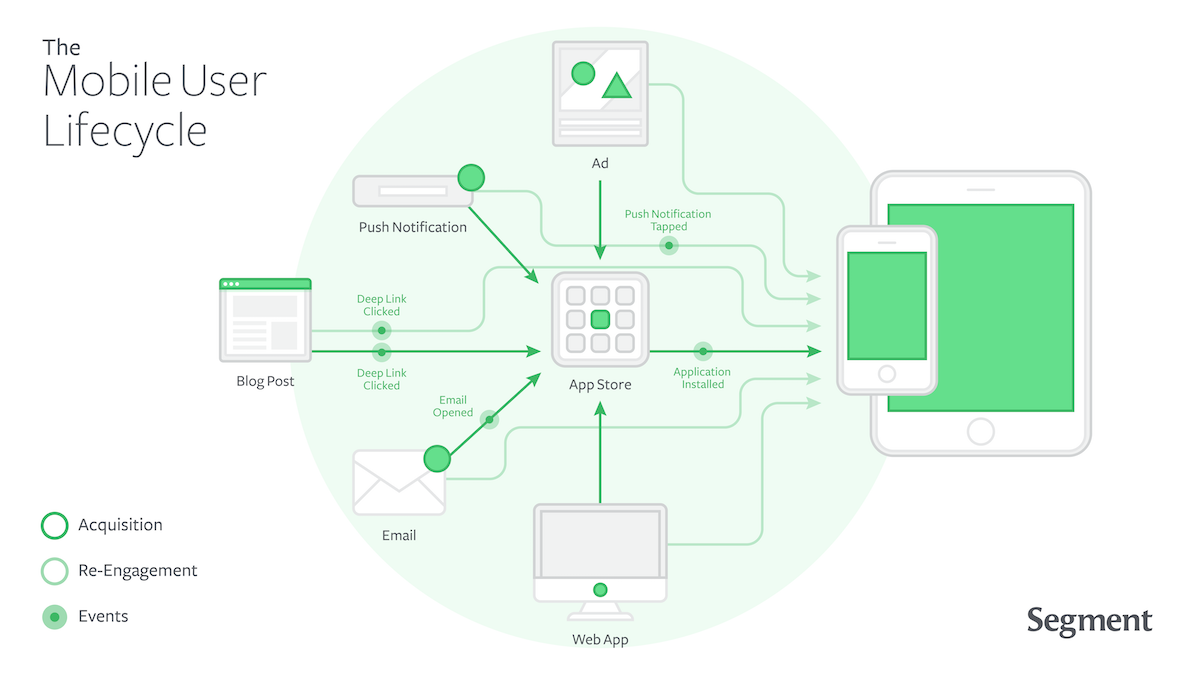Introducing the Native Mobile Spec
Jun 8, 2016
By Chris Sperandio
We’re incredibly excited to share that Segment’s customer data platform is now powering the analytics stack for over 3,000 mobile apps, including our friends at HomeAway, HotelTonight, Instacart, VSCO and DraftKings. Collectively, these apps have over 500 million downloads, and we’ve been poring over our data and conversations with these customers to build you something new: the Native Mobile Spec.
Over the last three years, our customers have taught us that it’s particularly tricky to understand the customer journey on mobile. Users might find your app through an ad, download it, not purchase anything, come back through a push notification, discover a different product, and buy that one instead. How could you analyze that complex of a customer journey and attribute it to business efforts? Our customers told us the answer was “a long story.”
We want to make it easy for you to collect and analyze each of these touch points. That’s why we’ve released the Native Mobile Spec, a standard blueprint for automatically tracking key events across the mobile user lifecycle.

Automatic Event Tracking
Our core product has always stripped away redundant analytics tracking with a single library for capturing user events. The Native Mobile Spec will save you even more engineering time, since you no longer have to code in essential user events one by one.
We analyzed the analytics implementations of more than 3,000 different apps to define the Native Mobile Spec. Now Segment’s iOS and Android SDKs automatically track these essential user interactions:
To view the full details, see our documentation. If you’re an existing Segment mobile customer, you can opt-in to receive these events.
Application Installed— User installs your application for the first timeApplication Opened— User opens your applicationScreen Viewed— User is shown a new screenOrder Completed— User completes a transaction on your appApplication Updated— User updates to a newer version of your app
A Lighter App
The Native Mobile Spec will also slim down the size of your app because you can move key integrations, like Facebook App Events, to the server-side instead of bundling them in the Segment SDK. This functionality is available for customers that opt-in to automatic event collection and for those who instrument their own events that respect the Native Mobile Spec.
Our new server-side Facebook App Events integration powers popular features like Facebook App Analytics, dynamic product ads, custom audience creation, and conversion tracking with events captured by the Native Mobile Spec. That’s saving you 1,160 KB on iOS and 4,000 methods on Android by moving the integration to the server-side!
Soon, we’ll be rolling out similar functionality with server-side integrations updates for Google Adwords, covering Conversion Tracking, as well as Salesforce Marketing Cloud’s Predictive Intelligence feature to better tailor your messages.
Essential Mobile Metrics
With the new SDK update, you’ll be able to get your marketing and product teams up and running with our integration partners even faster. Now that Segment automatically collects key lifecycle events, you can start measuring top mobile metrics without any tracking code.
You can report on these essential metrics in your favorite analytics tools like Mixpanel, Localytics, and Amplitude, or easily create dashboards in your BI tools like Tableau, Looker, and Mode with the data collected from the Segment SDK.
Installs per Day
Daily Active Users
Monthly Active Users
Session Length
Session Interval
Average Revenue Per User
Average Revenue Per Paying User
Coming Soon: Capturing Campaign Events
Nearly 22% of all apps downloaded are used only once, but the cost of acquisition is close to $5 a pop! That’s why it’s imperative to measure which of your acquisition campaigns drive the most valuable users, and to bring users back with the right mix of push, email, and SMS.
To help you measure these campaigns, the Native Mobile Spec also details deep linking, push notification, and attribution events. (Our Twilio source covers SMS!). In the next few weeks we’ll be releasing updates to our mobile SDK and mobile marketing integrations to automatically collect these events and fan them out to your analytics tools and warehouses for the first time.
Install AttributedDeep Link ClickedDeep Link OpenedPush Notification ReceivedPush Notification TappedPush Notification Bounced
You’ll be able to understand the complete lifecycle of your mobile users and accurately measure the impact of your campaigns by combining your marketing events, in-app behavior, and revenue into one dataset powered by Segment.
We’re excited to continually improve the Segment customer data platform, helping you collect, combine and access data across all of your customer touch points. The Native Mobile Spec is just the beginning! Stay tuned for a wave of updates designed specifically to address the needs of mobile app companies.
Not a Segment customer yet? Request a demo or sign up today!
The State of Personalization 2023
Our annual look at how attitudes, preferences, and experiences with personalization have evolved over the past year.
Get the report
The State of Personalization 2023
Our annual look at how attitudes, preferences, and experiences with personalization have evolved over the past year.
Get the report
Share article
Recommended articles
How to accelerate time-to-value with a personalized customer onboarding campaign
To help businesses reach time-to-value faster, this blog explores how tools like Twilio Segment can be used to customize onboarding to activate users immediately, optimize engagement with real-time audiences, and utilize NPS for deeper customer insights.
Introducing Segment Community: A central hub to connect, learn, share and innovate
Dive into Segment's vibrant customer community, where you can connect with peers, gain exclusive insights, and elevate your success with expert guidance and resources!
Using ClickHouse to count unique users at scale
By implementing semantic sharding and optimizing filtering and grouping with ClickHouse, we transformed query times from minutes to seconds, ensuring efficient handling of high-volume journeys in production while paving the way for future enhancements.